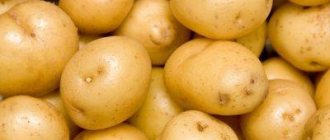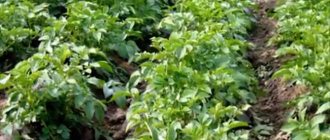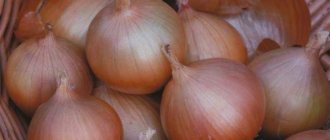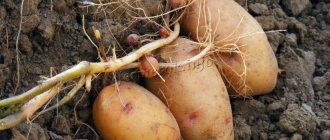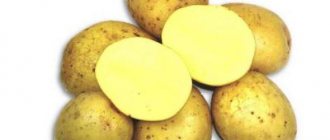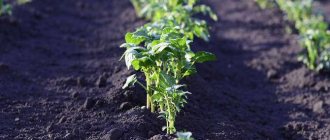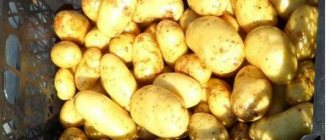History of the variety
It was bred by Belarusian breeders at the beginning of the 21st century by crossing the Kolya and Zhivitsa varieties, and quickly received good reviews both from scientists and at agricultural exhibitions. The variety was added to the register of agricultural crops of Belarus in 2008, but has become widespread in areas with an average climate far beyond the borders of the state.
In 2011, the crop was added to the Russian agricultural register, after which its distribution began in the CIS countries. Currently, the variety is more popular among farmers than among gardeners, mainly due to its small age.
Description of potato variety Uladar
Uladar is an early-ripening, high-yielding potato variety. Characterized by fairly large tubers and compact bushes. It is especially valued by farmers for its speed of ripening: the period from germination to harvest is 55-60 days. This allows you to grow the crop in regions with a cool climate, and at moderate temperatures - harvest 2 harvests per year. At the same time, it is possible to get a good harvest from a small garden area.
Escape. Uladar potato bushes reach a height of 55-60 centimeters, grow quite evenly, not crumbly. The leaves themselves are bright green with a wavy edge. A distinctive feature of potatoes is their red-violet flowers, which are quite difficult to confuse with another variety.
The structure of the shoots makes it easier to care for the crop, watering, fertilizing, loosening the soil, and controlling pests and diseases. To ensure that the leaves receive enough light and the tubers have enough space, it is recommended to plant potatoes with a density of no more than 500 tubers per hundred square meters.
Roots. On average, there are from 8 to 12 potatoes per bush, weighing 100-140 grams. The rind is yellow in color, ranging from almost white to bright yellow, depending on the type of soil and fertilizer. The peel is soft to the touch, there are no characteristic roughnesses. The flesh is also yellowish and retains its color when heated.
The potatoes are round and similar to each other, but sometimes there are also oblong tubers. Small eyes are a nice bonus for consumers. Even if the root crop germinates while lying indoors, the shoots can be easily cut out and then consumed.
Landing rules
The timing of planting Uladar potatoes directly depends on the composition of the soil. When grown on sandy loam and sandy soil, it should be carried out together with early grains. And on loams and heavy soils, planting should be done 5-7 days later.
Based on the description of the variety, Uladar potatoes require a sufficient amount of nutrients. Therefore, you should first prepare the site, namely, carry out deep plowing in 7-10 days. At the same time, add rotted organic matter to the soil in a proportion of 200 kg per 1 hundred square meters. If it is not available, you can replace it with mineral fertilizers: potassium salt, nitroammophoska, ammonium nitrate, 1 kg for the same size of garden.
Important! The preparation of Uladara tubers is carried out according to the standard scheme, which consists of warming up and greening for 10 days. When planting, tubers need to be buried 8-10 cm, and on clay soil 6-7 cm
In the row you should maintain a distance of 35 cm, and between them - 60 cm. Maintaining such a distance guarantees good ventilation and lighting of the bushes, and this will also allow hilling to be carried out without problems
When planting, the tubers need to be deepened by 8-10 cm, and on clay soil by 6-7 cm. A distance of 35 cm should be maintained in the row, and 60 cm between them. Maintaining such a distance guarantees good ventilation and lighting of the bushes, and will also allow Hilling up without problems.
Characteristics and features
The Uladar potato belongs to the early-ripening table varieties. The harvest in the form of young potatoes can be dug up within 40-45 days after planting, and the period until full ripening is no more than 75 days. The peculiarity of the variety is the fairly high density of the root crop. Thanks to this, it is stored for a long time and is resistant to mechanical damage.
The plant tolerates short-term drought well, so it is widespread in temperate climates. The crop is not well adapted to arid climates and requires regular watering.
Potato bushes put down quite powerful roots, which are not only resistant to dry soils, but also grow well, providing high yields on light and medium soils (in terms of particle size distribution). The powerful root system allows you to grow root crops on other soils. The variety is quite unpretentious.
Disease resistance
A bonus to the unpretentiousness of the Uladar potato is its high level of disease resistance. Among the advantages of the variety are complete immunity to potato cancer and nematode, as well as a high resistance to scab, late blight of tubers, rhizoctonia and other viruses. However, the leaves are still susceptible to late blight to a large extent, and the variety lacks natural protection against the Colorado potato beetle.
Productivity and taste
The variety is an early ripening potato with high yield. The maximum potato size is 180 grams. From one bush you can get up to two kilograms of potatoes. The average yield of the variety is 60 tons per hectare, the maximum is 71.6 tons. Early digging, as a rule, gives less results, with the yield being about 25-30 tons per hectare.
Features of the tuber are low starch content (11.5-17.8%) and sugars (0.4-0.45%). Therefore, it is not recommended to produce Uladar starch from potatoes. Potatoes have excellent taste and are classified as table varieties. Due to the composition and structure of the fruit, it is difficult to boil, but retains its taste during prolonged heat treatment. Experts note the high level of shelf life of potatoes (94%) and the pleasant presentation of the root crop (91-99%) due to its resistance to mechanical damage.
Advantages and disadvantages
The Uladar potato is considered the most promising among other varieties bred by Belarusian breeders. Why? Let's list its main advantages.
- Super early ripeness. The full growing season lasts 70 days, but you can start enjoying young tubers already on the 45th day from the moment they are planted in the ground.
- Double harvest. In the southern part of the country, an attempt to plant Uladar twice in one season will be successful; a high yield is guaranteed both after the first and after the second planting.
- High yield. This is perhaps the most important distinguishing feature of this variety. Under favorable conditions, up to 60 tons of high-quality potatoes can be harvested per hectare, and this is not the limit. A record was recorded when Uladar produced as many as 71 tons of selected potatoes from one hectare!
- Unpretentiousness. The variety easily tolerates periods of summer heat; it is completely undemanding to the soil. But still, preference should be given to soils with light or medium texture; on heavy ones, the yield will noticeably decrease.
- Application. Uladar is considered a high-quality table variety. It is excellent at transporting over long distances, so it is often grown for export to other countries. These potatoes also store well and can be used until the next harvest.
- Excellent taste. Potatoes have a pleasant taste and aroma and do not become soggy when cooked. If you fry the pieces in olive oil or goose fat, they will acquire a crispy crust, while the flesh will remain tender, almost melting in your mouth.
- Resistance to certain diseases. Uladar rarely suffers from potato cancer, is not afraid of nematodes, and is not afraid of wrinkled and striped mosaics.
The only significant drawback of the variety is that it is sometimes affected by late blight (both tops and tubers); in addition, in dry conditions the leaf curl virus can appear. In all other respects, this potato does not cause any complaints.
Advantages and disadvantages
The Uladar potato variety has received good reviews from experts and farmers due to its many advantages and few disadvantages. The advantages include:
- high productivity;
- rapid ripening, allowing planting and harvesting 2 times per season;
- good level of disease resistance;
- the rigidity of the fruit ensures long-term storage;
- unpretentiousness to growing conditions, compatibility with most soils, drought resistance;
- pleasant taste;
- resistance to mechanical damage;
- uniformity of potatoes, pleasant appearance.
However, the variety is not without a few drawbacks. The main disadvantages include low immunity to some diseases and pests, in particular the Colorado potato beetle. To eliminate the shortcomings, it is recommended to treat the potatoes before planting, as well as to care for the bushes after germination, treating them against pests.
Care
Speaking of care, everything is standard here. Potatoes love watering, fertilizing, hilling and protection from diseases and parasites.
Speaking of watering, experienced gardeners recommend watering potatoes no more than three times during certain periods of the growing season. The first time is when the sprouts appear, when they come out 5-6 cm. The second time is when the potatoes enter the flowering phase and the third time when they come out of it. It is not recommended to water the crop after flowering, as there is a high risk of contracting late blight.
Potatoes are also responsive to fertilizing. Especially if they were carried out in the autumn. After harvesting, the area is dug up and fertilized with manure or compost. In general, Uladar does not need to be fed any more. Autumn fertilizers will be sufficient.
Hilling is carried out as the tops grow. During the season you need to hill the crop twice. The first time, when the tops reached 15-25 cm, the second, 2-3 weeks after the first hilling. During hilling, it is necessary not only to hill up the potatoes with soil, but also to clear the area of weeds that inhibit the development of tubers.
Naturally, if a crop encounters the Colorado potato beetle, it is necessary to treat it with special insecticides. With diseases, everything is the same, only fungicides are used.
Features of planting and growing Uladar potatoes
To obtain a large potato harvest, you must follow all the rules. With early planting, the first root crops can be harvested in early June, after which they can be replanted and get another harvest in the fall.
Growing potatoes of the Uladar variety does not require special agrotechnical measures. At the same time, we should not forget that the quality of the crop depends on moisture, soil composition (fertilizers), and the effectiveness of pest control.
You can learn more about the size of Uladar potato bushes in mid-summer by watching this video:
Preparing the site for planting
Before growing potatoes, careful soil preparation is required. Nitrogen is required for the growth of tubers and the supply of nutrients obtained through photosynthesis to the root crop. To fill and ripen tubers, potassium and phosphorus fertilizers are required.
Farmers recommend adding both organic (humus, manure) and mineral fertilizers to the soil. According to the rules, organic fertilizers are applied in advance (in autumn or early spring) when plowing the soil. Mineral fertilizers are used during planting and during the growing period. Otherwise, some of the necessary elements will be washed away with water. Immediately before adding tubers to the soil, it is necessary to water it until it is moist.
Tuber preparation
Before planting, potatoes are germinated to form sprouts. To do this, the tubers are transferred to a room with a temperature of 10-15°C. After 2-3 weeks, the potatoes are inspected for the presence of sprouts.
Next, the measures necessary to combat root crop diseases are taken. To do this, potatoes are inspected during preparation for planting in the ground, diseased tubers are discarded, and then kept for 20-30 minutes in a weak solution of hydrogen peroxide or potassium permanganate.
The peculiarity of the Uladar potato variety is that it tolerates cutting well. If there are a large number of sprouts, the fruit is cut into 2-3 parts.
Each part should not be less than 30-35 grams, otherwise the sprout will not have enough resources to germinate.
Planting in the ground, planting scheme
The depth of planting tubers directly depends on the humidity of the climate and soil. Planting is carried out in moist soil when its temperature does not fall below +10°C. For humid climates, a depth of 5-6 centimeters is sufficient. In this case, the crop is planted using the ridge method.
In arid climates, the crop is planted at a greater depth - 10-12 centimeters. Due to the small size of the bushes, the distance between the tubers is 25-30 centimeters, and between the rows - about 60 centimeters for ease of caring for the crop.
Fertilizer application
After planting, potatoes must be fed with fertilizers. If nitrogen is added with humus in advance, then potassium and phosphorus are needed after the appearance of root crops. Therefore, you should fertilize the soil several times a season. Nitrogen needs to be added only if the bushes are not large enough and have a yellowish tint. At the same time, you need to be as careful as possible with this substance.
Excess nitrogen negatively affects the yield.
Care
Caring for the crop is the key to a good harvest. For potatoes to grow, they need:
- water;
- weed;
- spud.
Potatoes are watered at least 3 times per season. However, this figure is being adjusted. In a humid climate, the crop can do without watering at all, but in particularly dry regions it is necessary to carry out this procedure at least 6-8 times per season. During irrigation, it is possible to apply phosphorus or complex fertilizers. Potatoes tolerate slight drought very well, so you need to be careful not to overdo it with watering.
Weeding is carried out 2-3 times. Weeds can take away some of the nutrients, so you should get rid of them in a timely manner. The first weeding is carried out when the stems reach a height of 5-10 centimeters and are significantly different from weeds.
Hilling up the crop occurs when the bushes reach a height of 10 centimeters. The soil must be constantly maintained in a loose state by hilling to provide the tubers with oxygen. Mulching the beds also has a beneficial effect on the harvest.
Additionally, read how to make a potato hiller yourself from an old bicycle.
How to grow
The variety can grow on any type of soil. But the plant is demanding on the amount of nitrogen and phosphorus; there must be a lot of potassium in the soil.
Dates, scheme and rules of planting
Before planting, potatoes are selected, removing rotten and disease-damaged specimens. Next it is germinated. To do this, the potatoes are placed in a dark, warm room with a temperature of +13…+15°C. After a couple of weeks, the fruits are examined for the presence of sprouts. Before planting, seed potatoes are kept in a solution of potassium permanganate.
If there are a lot of sprouts, then the tuber is cut into 2-3 parts. Each part must be at least 35 g, otherwise the sprout will not be able to sprout from the ground.
Planting is carried out in May, when the soil warms up to +8...+1°C at a depth of at least 6-7 cm.
At the same time, mineral mixtures are added to the soil and fertilized with compost. On the day of planting, it is advisable to treat the tubers strictly according to the instructions with pest control agents - “Prestige”, “Commander”.
Next steps are:
- Make holes or furrows of suitable depth. The planting pattern is traditional. The width between tubers is at least 35 cm, between rows - 60-70 cm.
- Place the seed potatoes, sprouts up, in moist soil to a depth of 8-10 cm. If the soil is clayey, then 6-7 cm is enough. In areas with low humidity - 12 cm.
- Cover the holes with soil mixed with fertilizer.
- Carefully level the surface of the soil with the planted potatoes.
You can add wood ash and onion peels to the soil along with the tubers - this will repel pests. Nitrogen-containing mixtures should be excluded during this period.
Care
For a high yield, the following agrotechnical measures are necessary:
- watering;
- weeding;
- loosening and hilling;
- application of fertilizers.
Typically, 3-4 waterings are carried out per season. But this depends on climatic and weather conditions, the condition of the bushes and soil.
The soil needs to be periodically loosened and weeds removed. Loose soil better saturates the roots with oxygen and allows rain moisture to pass through.
Hilling of the bushes is carried out when the plantings reach a height of 10 cm. The procedure is repeated before flowering. During this time, the plants grow up to 20 cm. Hilling is carried out for the third time when the potato bushes become about 30 cm high. The mounds with soil are made at least 20 cm high.
After planting, the plant needs fertilizers with potassium and phosphorus - “Superphosphate”, “Kalimagnesia”. It is enough to apply them several times during the season.
Nuances of cultivation and possible difficulties
The Uladar variety is not demanding on moisture, but prolonged drought will negatively affect the harvest.
If you do not hill up the bushes, the yield will also decrease. An important feature of this variety is the intensive formation of tubers in the first half of the growing season. At this time, the crop must be actively fed.
The variety is immune to some potato diseases:
- potato cancer;
- potato nematode;
- common scab;
- fusarium rot;
- Alternaria blight.
But the danger for tubers is rhizoctonia, due to which you can lose 30% of the seedlings. For prevention, root crops are treated with the Maxim fungicide before planting.
Of the pests, the main enemy is the Colorado potato beetle. In the middle of tuber ripening, the number of insects increases sharply. If there are a lot of plantings, you will have to treat them with insecticides. Spraying is carried out according to the instructions on the package. The drugs “Aktara”, “Kinmiks”, “Bankol” are suitable.
Protection from diseases and pests
After the first shoots, during weeding or hilling, the plants are inspected for diseases. If leaf curling is detected, the bushes are treated with a solution of potassium permanganate or peroxide, however, due to the characteristics of the variety, such problems arise quite rarely.
The fight against the Colorado potato beetle when growing the Uladar variety should be systematic. A few days after hilling, it is necessary to collect pests so that the beetles do not lay eggs. Next, if there is a large accumulation of the Colorado potato beetle, the potatoes are treated with special means. The procedure is performed according to the instructions on the package. Typically, this remedy lasts 20-30 days, after which the bushes are treated again due to their low resistance to parasites.
Bushes should be treated with different means, based on different active ingredients, due to resistance to drugs that occurs in Colorado beetles.
Harvest and storage
Harvesting takes place 60-65 days after planting. When the tubers ripen, the leaves on the bushes will fall off, but the tops will still remain green. This time is considered optimal for digging. To obtain young potatoes, 40-45 days are enough, after which you can prepare the soil and replant the crop.
The resulting crop must be cleared of soil, dried and ventilated in the open air. Next, sorting is carried out, damaged and defective potatoes are selected. After this, the root crop is placed in a cool, dry place without access to sunlight for storage.
Read a detailed article about harvesting and storing potatoes.
Reviews
★★★★★
Yuri Maksimovich, farmer. I have been planting Uladar potatoes for several years now.
In our hot climate the bushes performed well. I can safely leave the farm for a few days without fear of the crop drying out. I leave about half a ton of potatoes for myself and my family. I was very surprised when in the spring I found only a dozen wilted tubers per bag of potatoes. The culture is stored well. ★★★★★
Dmitry Alexandrovich, gardener. This variety is a real find.
I live in the northern zone, winter comes early here, and it is not possible to plant potatoes before the end of May. This variety is excellent, it has time to ripen and pleases with the harvest. Now we have enough potatoes, and we eat our own organic fruits grown in the garden all year round. ★★★★★
Irina Anatolyevna, housewife. My parents bought a new variety of potatoes for the garden.
I don’t know if it’s this variety, or if they started growing it differently, but there are more potatoes. This year they often gave us several kilograms, until May. Cooking potatoes is a delight. My husband especially likes it baked. It stores well even in the pantry (although the temperature is not the most comfortable for it), and our whole family really likes it for its excellent taste. Hide
Add your review
Potato Uladar has collected positive characteristics from experts, farmers and ordinary gardeners. It is rightfully considered one of the most productive varieties in Belarus and the CIS countries. The variety gives a quick harvest, is unpretentious to growing and storage conditions, due to which it quickly spread among farmers and gardeners.
0
0
Copy link



